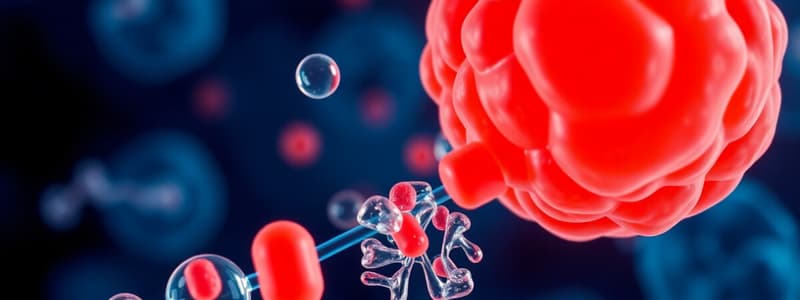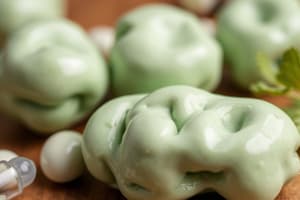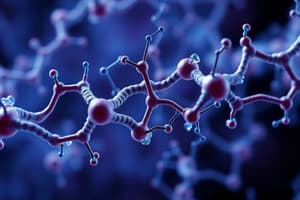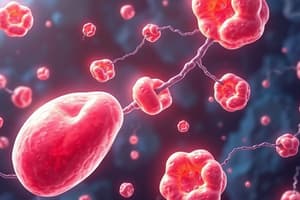Podcast
Questions and Answers
What is the primary role of cholesterol in the body?
What is the primary role of cholesterol in the body?
- Energy storage
- Structural component of biomembranes (correct)
- Nutrient transport
- Regulation of blood pressure
Which compound is considered the precursor of all steroid hormones?
Which compound is considered the precursor of all steroid hormones?
- Pregnenolone (correct)
- Vitamin D
- Cholesterol
- Cholic acid
How are lipoproteins primarily classified?
How are lipoproteins primarily classified?
- By their origin
- By their density (correct)
- By the type of lipids they contain
- By their size
Which of the following lipoproteins is synthesized in the intestine?
Which of the following lipoproteins is synthesized in the intestine?
How do lipoproteins with high lipid content behave when subjected to ultra centrifugation?
How do lipoproteins with high lipid content behave when subjected to ultra centrifugation?
What is the function of bile acids derived from cholesterol?
What is the function of bile acids derived from cholesterol?
Which of the following compounds is NOT derived from cholesterol?
Which of the following compounds is NOT derived from cholesterol?
What does the term 'amphipathic' describe in the context of bile acids?
What does the term 'amphipathic' describe in the context of bile acids?
Which apoprotein integrates into lipoproteins to facilitate lipid transport?
Which apoprotein integrates into lipoproteins to facilitate lipid transport?
Which of the following lipoproteins has the highest protein content and the lowest lipid content?
Which of the following lipoproteins has the highest protein content and the lowest lipid content?
What is the primary role of Vitamin K in the body?
What is the primary role of Vitamin K in the body?
Which of the following food sources is highest in Vitamin K?
Which of the following food sources is highest in Vitamin K?
What can cause a deficiency in Vitamin K?
What can cause a deficiency in Vitamin K?
How does Vitamin E function in the body?
How does Vitamin E function in the body?
Which of the following forms of Vitamin K is synthetic?
Which of the following forms of Vitamin K is synthetic?
What happens when an individual takes anticoagulant drugs such as Warfarin?
What happens when an individual takes anticoagulant drugs such as Warfarin?
Which vitamin deficiency is associated with easy bruising?
Which vitamin deficiency is associated with easy bruising?
What is a common symptom of Vitamin K deficiency in newborns?
What is a common symptom of Vitamin K deficiency in newborns?
Which of the following vitamins can lead to toxicity if taken in excess?
Which of the following vitamins can lead to toxicity if taken in excess?
Which vitamin is critical for calcium absorption in the body?
Which vitamin is critical for calcium absorption in the body?
What is the final active form of vitamin D?
What is the final active form of vitamin D?
What are the consequences of severe vitamin A deficiency?
What are the consequences of severe vitamin A deficiency?
What is a potential consequence of vitamin D toxicity?
What is a potential consequence of vitamin D toxicity?
Which vitamin promotes the formation of Calbindin in intestinal mucosal cells?
Which vitamin promotes the formation of Calbindin in intestinal mucosal cells?
What is rickets primarily caused by?
What is rickets primarily caused by?
What is one food source high in vitamin D?
What is one food source high in vitamin D?
What role does vitamin E play in the body?
What role does vitamin E play in the body?
How is cholecalciferol activated in the body?
How is cholecalciferol activated in the body?
Which of the following conditions is associated with vitamin D deficiency in adults?
Which of the following conditions is associated with vitamin D deficiency in adults?
Which is a common cause of vitamin D deficiency?
Which is a common cause of vitamin D deficiency?
Which vitamin is primarily involved in vision through the regeneration of cis-retinal?
Which vitamin is primarily involved in vision through the regeneration of cis-retinal?
Which characteristic distinguishes fat soluble vitamins from water soluble vitamins?
Which characteristic distinguishes fat soluble vitamins from water soluble vitamins?
What role does retinoic acid play in the body?
What role does retinoic acid play in the body?
Which of the following foods is an excellent source of preformed vitamin A?
Which of the following foods is an excellent source of preformed vitamin A?
What is a characteristic of carotenoids?
What is a characteristic of carotenoids?
Which fat soluble vitamin is essential for maintaining reproductive health?
Which fat soluble vitamin is essential for maintaining reproductive health?
What is the expected consequence of vitamin A deficiency?
What is the expected consequence of vitamin A deficiency?
What is required for the absorption of dietary beta carotene?
What is required for the absorption of dietary beta carotene?
Which of the following fat soluble vitamins is important for blood clotting?
Which of the following fat soluble vitamins is important for blood clotting?
Which statement correctly describes the storage of fat soluble vitamins?
Which statement correctly describes the storage of fat soluble vitamins?
Flashcards
Steroids
Steroids
A type of lipid with a specific four-ring structure. They are essential for various biological functions.
Cholesterol
Cholesterol
A type of steroid found in cell membranes and used to make other essential steroids. It's present in animal products.
Bile Acids
Bile Acids
Polar derivatives of cholesterol produced in the liver, aiding in the digestion of fats.
Steroid Hormones
Steroid Hormones
Signup and view all the flashcards
Lipoproteins
Lipoproteins
Signup and view all the flashcards
Apoproteins
Apoproteins
Signup and view all the flashcards
Chylomicrons
Chylomicrons
Signup and view all the flashcards
VLDL
VLDL
Signup and view all the flashcards
HDL
HDL
Signup and view all the flashcards
LDL
LDL
Signup and view all the flashcards
Vitamin K Role
Vitamin K Role
Signup and view all the flashcards
Vitamin K Forms
Vitamin K Forms
Signup and view all the flashcards
Vitamin K Deficiency
Vitamin K Deficiency
Signup and view all the flashcards
Vitamin K and Food
Vitamin K and Food
Signup and view all the flashcards
Vitamin K and Anti-clotting Drugs
Vitamin K and Anti-clotting Drugs
Signup and view all the flashcards
Vitamin E Storage
Vitamin E Storage
Signup and view all the flashcards
Vitamin E Deficiency
Vitamin E Deficiency
Signup and view all the flashcards
Vitamin E Destruction
Vitamin E Destruction
Signup and view all the flashcards
Vitamin E Function
Vitamin E Function
Signup and view all the flashcards
Vitamin E Sources
Vitamin E Sources
Signup and view all the flashcards
Fat Soluble Vitamins
Fat Soluble Vitamins
Signup and view all the flashcards
Provitamin A
Provitamin A
Signup and view all the flashcards
Vitamin A Absorption
Vitamin A Absorption
Signup and view all the flashcards
Vitamin A Role in Vision
Vitamin A Role in Vision
Signup and view all the flashcards
Vitamin A Role in Cell Growth
Vitamin A Role in Cell Growth
Signup and view all the flashcards
Vitamin A and Reproduction
Vitamin A and Reproduction
Signup and view all the flashcards
Carotenoids and Antioxidants
Carotenoids and Antioxidants
Signup and view all the flashcards
Vitamin A Sources - Animal
Vitamin A Sources - Animal
Signup and view all the flashcards
Vitamin A Sources - Plant
Vitamin A Sources - Plant
Signup and view all the flashcards
Nyctalopia
Nyctalopia
Signup and view all the flashcards
Xerophthalmia
Xerophthalmia
Signup and view all the flashcards
Vitamin A Toxicity
Vitamin A Toxicity
Signup and view all the flashcards
Vitamin D Synthesis
Vitamin D Synthesis
Signup and view all the flashcards
Vitamin D Activation
Vitamin D Activation
Signup and view all the flashcards
Calcitriol
Calcitriol
Signup and view all the flashcards
Calbindin
Calbindin
Signup and view all the flashcards
Rickets
Rickets
Signup and view all the flashcards
Osteomalacia
Osteomalacia
Signup and view all the flashcards
Study Notes
Lipids-III: Steroids and Lipoproteins
- Learning Objectives:
- Identify the basic structure of steroids.
- List important cholesterol-derived compounds and their functions.
- Classify lipoproteins based on physical and chemical properties.
- Describe the role of lipoproteins in lipid transport.
Cholesterol
- Structure and Function:
- Component of biomembranes and plasma lipoproteins.
- Precursor for other steroids.
- Present in animal-origin foods (egg yolk, meat, liver, brain).
- Cholesterol ester is the storage form (completely hydrophobic).
Cholesterol Functions
- Structural Component: A key structural component of cell membranes and lipoproteins.
- Precursor for Steroids: Building block for steroid hormones (estrogen, testosterone), vitamin D, and bile salts.
Bile Acids
- Metabolism: End product of cholesterol metabolism in the liver.
- Characteristics: Polar (water-soluble) derivatives of cholesterol; contain cholic acid and chenodeoxycholic acid; amphipathic (hydrophilic and hydrophobic).
- Function: Act as detergents, aiding in fat digestion.
Steroid Hormones
- Production: Made primarily in adrenal glands and gonads.
- Conversion: Cholesterol is converted to pregnenolone (21-carbon steroid).
- Pregnenolone: Considered the precursor of all steroid hormones.
Lipoproteins
- Composition: Complexes of lipids and proteins.
- Lipid Insolubility: Lipids are insoluble in aqueous mediums (blood).
- Transport Mechanism: Transported in blood by apoproteins.
- Apoprotein + Lipid = Lipoprotein
Lipoprotein Classification
- Classified by density (measured by ultracentrifugation) into five major types:
- Chylomicrons
- Very-low-density lipoproteins (VLDL)
- Intermediate-density lipoproteins (IDL)
- Low-density lipoproteins (LDL)
- High-density lipoproteins (HDL)
Chylomicrons
- Synthesis: Synthesized in the intestine.
- Function: Transport dietary triglycerides (TAGs) to adipose tissue and skeletal muscle.
- Characteristics: Low density, largest size among lipoproteins.
- Composition: Mostly TAGs (83%), along with cholesterol (8%), phospholipids (PLs) (7%), and proteins (2%).
VLDL
- Synthesis: Synthesized in the liver.
- Function: Transport endogenously synthesized TAGs from the liver to various tissues.
- Composition: Primarily TAGs, and some phospholipids (18%), cholesterol (22%), and proteins (10%).
LDL
- Formation: Derived from VLDL.
- Function: Transports cholesterol from the liver to peripheral tissues.
- Characteristics: Contains a high amount of cholesterol; high LDL blood concentration is linked to increased risk of atherosclerosis and cardiovascular disease.
- Composition: Primarily cholesterol (46%), with some TAGs (10%), phospholipids (22%), and proteins (22%).
HDL
- Function: Transports cholesterol from peripheral tissues to the liver for excretion in bile.
- Characteristics: "Good cholesterol"; helps remove cholesterol from peripheral tissues.
- Composition: Mostly proteins (33%), with cholesterol (30%), smaller amounts of TAGs (8%), and phospholipids (29%).
Studying That Suits You
Use AI to generate personalized quizzes and flashcards to suit your learning preferences.




